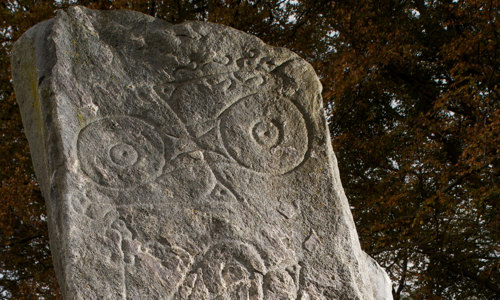History
The Maiden Stone is one of the best examples of Pictish sculptural stonework standing today. It’s 3m tall and made from pinkish granite. It was probably carved some time after AD 700, though this is debated.
It may be one of the last symbol-bearing monuments to have been erected in Aberdeenshire and probably stands close to its original location.
On one face of the cross is:
- a male figure flanked by two opposed sea monsters: possibly Jonah, escorted by two whales
- a ring-headed cross beneath the figure
- ornate carved patterns, including interlace, key-pattern and knotwork
The other side is divided into four panels, featuring carvings of a centaur and other animals. There’s also a notched rectangle with a Z-rod, a Pictish beast and a mirror with double-sided comb.
As a cross-slab, it’s an overtly Christian monument, and judging by its scale, it was probably intended as a significant marker in the landscape.
Stories of the stone
There’s a rich folk tradition attached to the Maiden Stone, and it’s still an active part of local folklore.
The stone’s traditionally linked with a daughter of the laird of Balquhain. She’s said to have made a wager with a stranger that she could bake a good supply of bread before he could build a road to the top of the nearby hill of Bennachie.
But the stranger turned out to be the Devil. He finished the road before the bread was ready, and returned to claim the maiden as a reward. As she fled, he caught her and transformed her into the Maiden Stone.
The stone may also be linked to St Medan, an early Christian missionary, about whom very little is known.
Reminders of the Picts
We don’t know a lot about the Picts, the descendants of Iron-Age tribes who occupied the area north of the Forth and Clyde estuaries in the first millennium AD. They left about 300 carved stones across the country, mainly in the north and east. The earliest of these stones, such as the Brandsbutt Stone, date to about AD 600 and display a variety of enigmatic symbols.
The Maiden Stone, probably erected after AD 700, bridges the gap between symbol stones and the later group of Pictish cross-slabs, which were largely carved in the AD 800s and were more overtly Christian.











